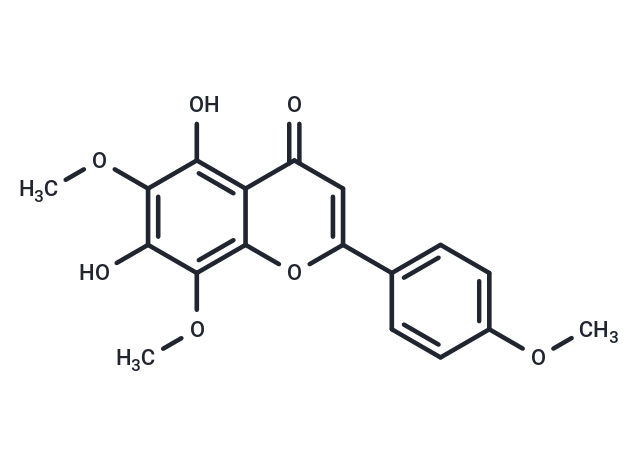Shopping Cart
- Remove All
 Your shopping cart is currently empty
Your shopping cart is currently empty

Nevadensin is an important herb-based constituent inhibiting estragole bioactivation. Nevadensin protects against a methyleugenol-induced marker of hepatocarcinogenicity in male F344 rat. It also exhibits inhibition activity against Mycobacterium tuberculosis, with equal MIC value of 200 microg/mL.

| Pack Size | Price | Availability | Quantity |
|---|---|---|---|
| 5 mg | $39 | In Stock | |
| 10 mg | $64 | In Stock | |
| 25 mg | $115 | In Stock | |
| 50 mg | $188 | In Stock | |
| 100 mg | $283 | In Stock | |
| 1 mL x 10 mM (in DMSO) | $54 | In Stock |
| Description | Nevadensin is an important herb-based constituent inhibiting estragole bioactivation. Nevadensin protects against a methyleugenol-induced marker of hepatocarcinogenicity in male F344 rat. It also exhibits inhibition activity against Mycobacterium tuberculosis, with equal MIC value of 200 microg/mL. |
| Targets&IC50 | CE1 (human):2.64 μM (IC50), CE2 (human):132.8 μM (IC50) |
| In vitro | The alkenylbenzene methyleugenol occurs naturally in a variety of spices and herbs, including basil, and their essential oils. At high dose levels methyleugenol induces hepatocarcinogenicity in rodents following bioactivation to 1'-sulfooxymethyleugenol which forms DNA adducts. METHODS AND RESULTS: This study investigated whether the inhibitory effect of the basil flavonoid Nevadensin on sulfotransferase (SULT)-mediated bioactivation of methyleugenol observed in vitro would also be reflected in a reduction of DNA adduct formation and a reduction in an early marker for liver carcinogenesis in an 8-week rat study. Co-exposure to methyleugenol and Nevadensin orally resulted in a significant inhibition of liver methyleugenol DNA adduct formation and in inhibition of hepatocellular altered foci induction, representing indicators for initiation of neoplasia. CONCLUSIONS: These results suggest that tumor formation could be lower in rodent bioassays when methyleugenol would be dosed in a matrix containing SULT inhibitors such as Nevadensin compared to experiments using the pure methyleugenol. |
| Alias | Pedunculin |
| Molecular Weight | 344.32 |
| Formula | C18H16O7 |
| Cas No. | 10176-66-6 |
| Smiles | O(C)C1=C2C(=C(O)C(OC)=C1O)C(=O)C=C(O2)C3=CC=C(OC)C=C3 |
| Relative Density. | 1.387 g/cm3 (Predicted) |
| Storage | Powder: -20°C for 3 years | In solvent: -80°C for 1 year | Shipping with blue ice. | |||||||||||||||||||||||||
| Solubility Information | DMSO: 14.71 mg/mL (42.72 mM), Sonication is recommended. | |||||||||||||||||||||||||
Solution Preparation Table | ||||||||||||||||||||||||||
DMSO
| ||||||||||||||||||||||||||

Copyright © 2015-2025 TargetMol Chemicals Inc. All Rights Reserved.